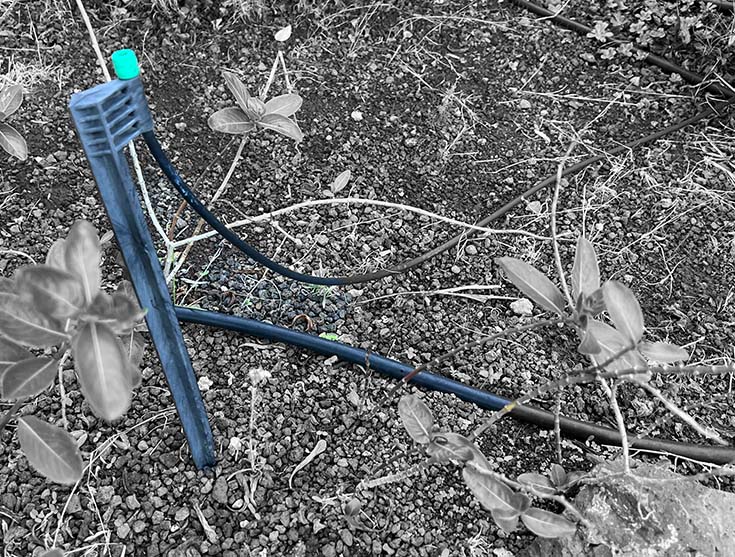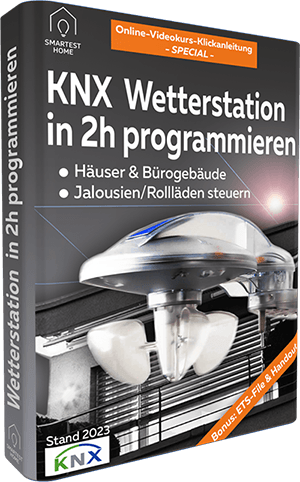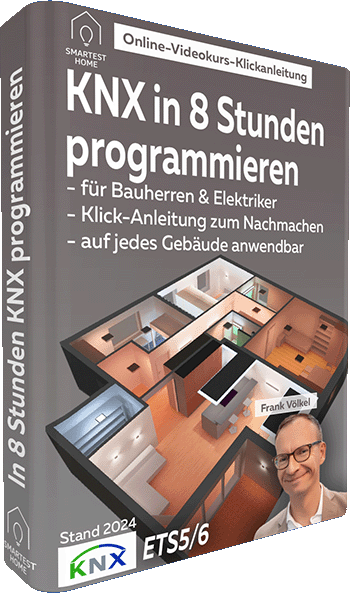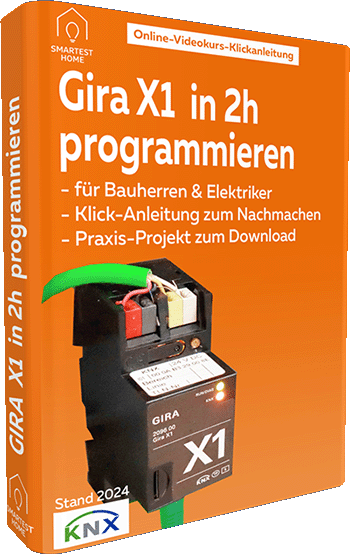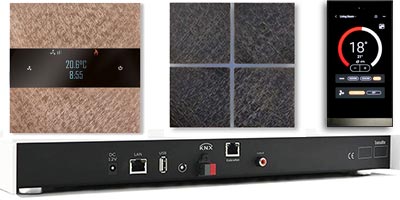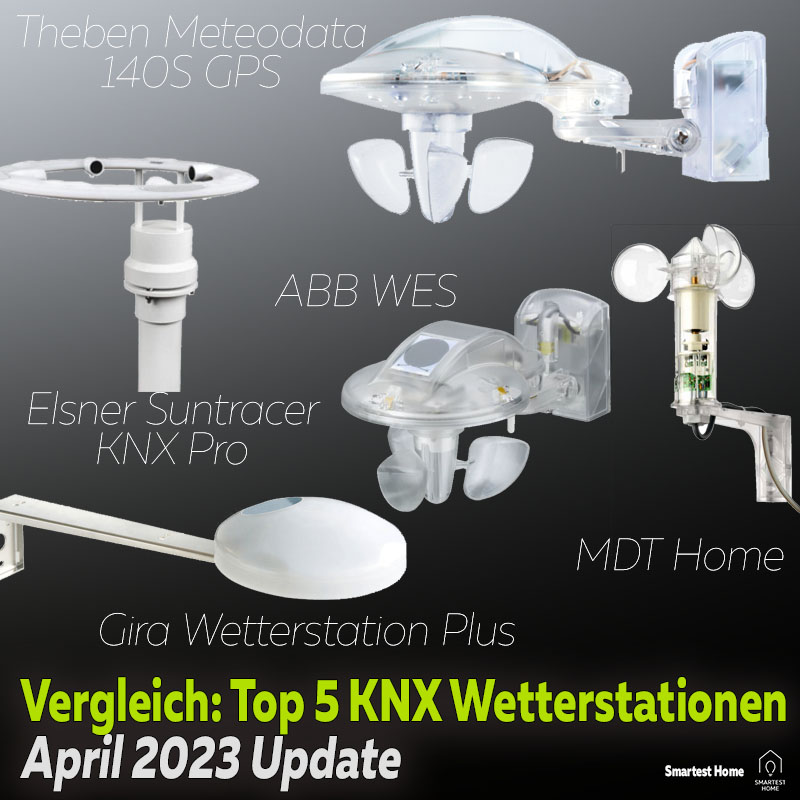
Let’s get straight to the point: Today, a KNX weather station is an essential part of the equipment of a KNX smart home, regardless of whether it is a new-build detached family house, a villa or a larger public building such as a town hall hotel or shopping mall.
This is so important because only a KNX weather station can ensure that the house is permanently and automatically protected from wind, rain, cold snaps and sunshine by measuring and constantly determining the local weather data “in front of the front door”. In addition, there is often the automatic watering control in the garden, in which the KNX weather station is also included. After all, the plants should not be stressed with cold water in blazing sunlight.
The theoretical alternative of importing weather data from the Internet via the IP network and using it to control the blinds and roller shutters in any way – that doesn’t work at all. Not even in 2023, when we can control many things via the Internet. This article is based on our practical experience with newly built houses and villas and is updated regularly (as of May 2023).
So let’s go and have a look at the good KNX weather stations that are available on the market today. From our practical experience, KNX weather stations have been around for almost 20 years. A lot has happened during this time and the product quality has been continuously improved by the manufacturers.
The equipment also fluctuates with the price, which should not play a decisive role or serve as a purchase criterion in view of a particularly long service life. In principle, the equipment of a KNX weather station is comparable to that of a KNX button: high-quality workmanship with many functions costs significantly more than reduced equipment and compromises in product quality. And not every weather station is recommended in our experience. More on why this is the case in this article.
The prices for a KNX weather station start at just over 300 euros and end at just over 2200 euros. All weather stations have the label “Made in Germany” in common, so if you value good quality, you’ve come to the right place. Included in the ratings are the price increases of the past 2 years, which we can put on average at 10 to 15 percent.
Table of contents KNX weather stations
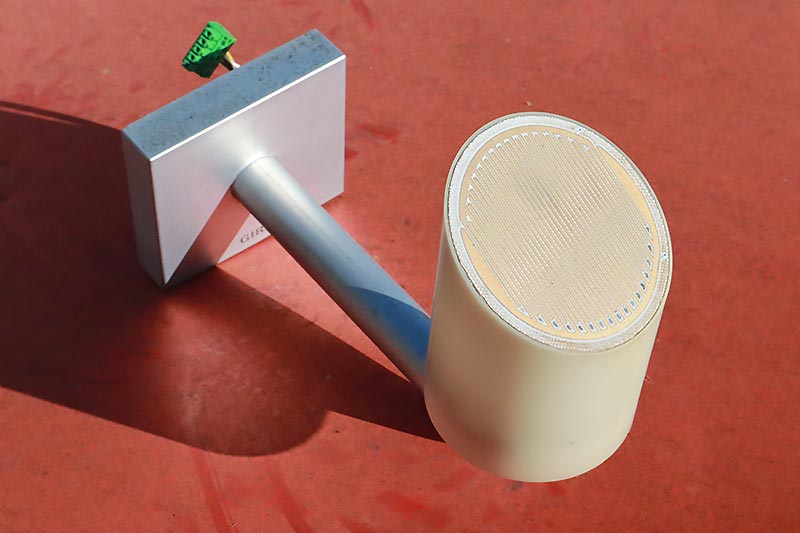
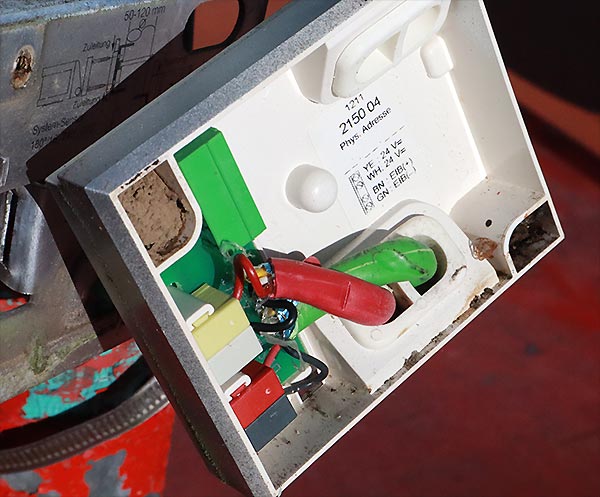
As is so often the case, the German company MDT serves the lowest price segment with the simple MDT weather station Home, followed by the Merten KNX weather station Basic, the Gira weather station KNX Standard, the Theben Meteodata 140 S KNX, the Busch-Jaeger weather station and the Siemens KNX Weather station GPS. The Elsner Suntracer KNX pro weather station offers the best price and performance.
This raises the question of what the main difference is between the cheap and expensive models? Before we go into detail: The Elsner Suntracer KNX pro weather station can, for example, control blinds/shutters on 12 different facades – with the MDT weather station Home there are only 3 facades.
Why did we call the Theben Meteodata 140 S KNX the “mother of all weather stations” in the video below? Because it is basically identical to four manufacturers: ABB, Busch-Jaeger, Merten and Siemens. The fact that the Gira KNX weather station Plus is manufactured by Thies Clima is not a bad thing either. After all, Gira has its real competencies in other areas of the KNX world. And there is a weather station that you should definitely not consider as a builder: The Gira Standard weather station, which in our experience breaks down more often.
If you want to delve deeper into the subject of the KNX weather station and want to automate and set up the shading on a more complex building with up to 8 facades, we can definitely recommend our video course “Programming the KNX weather station in 2 hours”.
Video course SPECIAL KNX weather station
– Quickly set up and program sophisticated shading on buildings with a KNX weather station in 2 hours
– Automation of blinds, shutters, awnings on any house with up to 8 facades and 60 windows
->more information about the video course
–
33-page graphic handout on basics, parameterization & programming
– Complete ETS5/ETS6 project for download and import
Who offers all good KNX weather stations?
- ABB WES weather sensor (identical to Theben Meteodata)
- Elsner Suntracer KNX per weather station (for 12 facades)
- Merten KNX weather station Basic (identical to Theben Meteodata)
- Theben Meteodata 140 S GPS KNX (for 8 facades)
- MDT weather station Home (for 3 facades)
- Gira KNX weather station Plus (by Thies Clima)
- Jung KNX weather station Home (identical to Gira weather station standard, less recommended)
- Siemens KNX weather station GPS (identical to Theben Meteodata)
- Busch-Jaeger weather station (identical to Theben Meteodata)
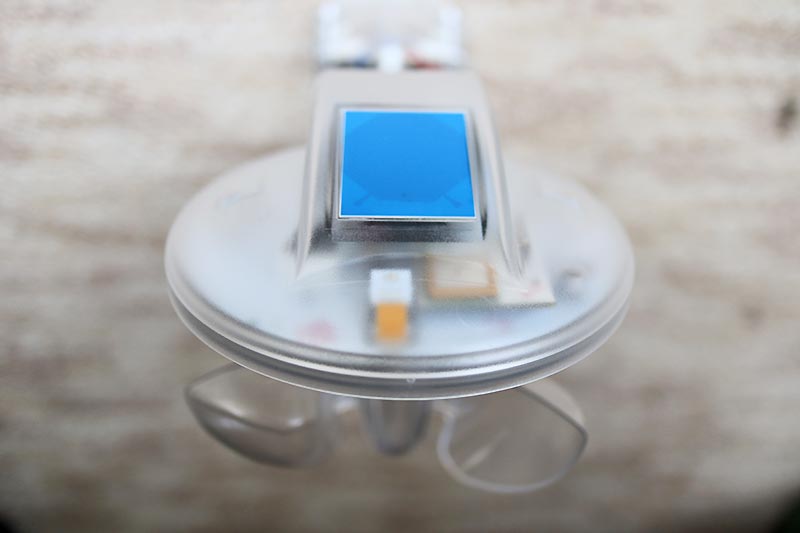
Which measured values does a KNX weather station record?
Depending on the equipment, a high-quality KNX weather station is equipped with up to 10 different sensors. The measuring accuracy and longevity of these sensors as well as the flexibility in the KNX parameterization ultimately also make up the price difference. The table below lists all possible measurement functions for weather stations.
Top 10 measurement functions of a KNX weather station:
- Brightness (North, East, South, West)
- Sun course (exact and by location)
- Wind speed (m/s or km/h, sometimes very precise)
- Wind direction
- Precipitation/rain, amount of precipitation
- Temperature
- Humidity
- Air pressure
- Global radiation (energy input roof, PV system)
- Date and time (GPS, location)
On the house roof: years or decades
First of all: All the KNX weather stations presented here are suitable for permanent use on the house roof or on the house wall. Lasting – that means for many years and usually decades. They all have an integrated KNX bus coupler. Although this has been standard for many years, we want to mention it again here.
What does a KNX weather station do?
In most house building projects, a KNX weather station is connected to a KNX server for visualization on touchscreens. The visualization enables the residents of the house to access the measured weather data and to display them in history / a timeline.
The actual benefit of a KNX weather station arises when the control of shading such as blinds, zip screens, external venetian blinds and awnings or the heating system is automatically adjusted according to the weather conditions.
This also means that if extreme weather threatens, such as storms or hail, the shading is automatically moved for protection without the residents having to do anything. Or if there is a threat of icing (rapid drop in temperature), the external venetian blinds are not retracted as usual for protection. Without a KNX weather station, the functions mentioned as examples could not be implemented in a house.
Basic functions of a KNX weather station
- automatic sun protection, shading control
- automatic tracking of the position of the sun (optional)
- control of blinds/shutters for up to 12 different facades
- support heating and cooling (winter/summer)
- safety and weather protection: storm, rain, hail
- privacy protection in the evening hours
- garden watering at the right time
- data/support photovoltaic system
Extreme weather conditions: 75°C heat to -30°C cold
A KNX weather station has to withstand all extreme weather conditions: Great summer heat on the roof with up to 75°C and high UV radiation and very cold winter temperatures of down to -30°C depending on the region in Germany or Switzerland. The material from which the KNX weather stations are made is subject to very high demands. It often only becomes apparent after many years where the weak points of a weather station really are.
From our experience, animals such as martens, birds, squirrels or insects, bees/wasps in particular endanger the service life of a weather station. Exposed (KNX) cables become porous within a few years due to UV radiation from the sun and can be nibbled on by birds or bitten off by martens. The result: the KNX weather station acknowledges its service.
What can a modern KNX weather station control?
Here are some examples from our practice:
- classic shutters on windows and doors, also floor-to-ceiling glazing
- classic blinds on the outside, even with room-high glazing
- modern external Venetian blinds
- modern zip screens outside
- roof windows with integrated shading, for example Velux and Roto
- pool cover for private outdoor swimming pools
- water valves for garden irrigation
A weather station performs many tasks in a family home or public building:
Sun protection and privacy at nightfall through automatic blinds/shutters.
Weather protection when the wind is too strong, protection against icing and storms, especially with awnings made of fabric or linen.
Irrigation control in the garden in connection with logic and home server – no building can do without a weather station.
Positioning of the manufacturers of KNX weather stations
The graphic below provides an overview of the positioning of the individual brands/manufacturers in the market for KNX weather stations. It is the result of our practical experience and thus our own assessment. The development and construction of a KNX weather station requires certain knowledge and cannot be implemented as quickly as is the case with certain KNX actuators, for example. It takes many years of experience and the right development tools to end up with a good and durable KNX weather station.
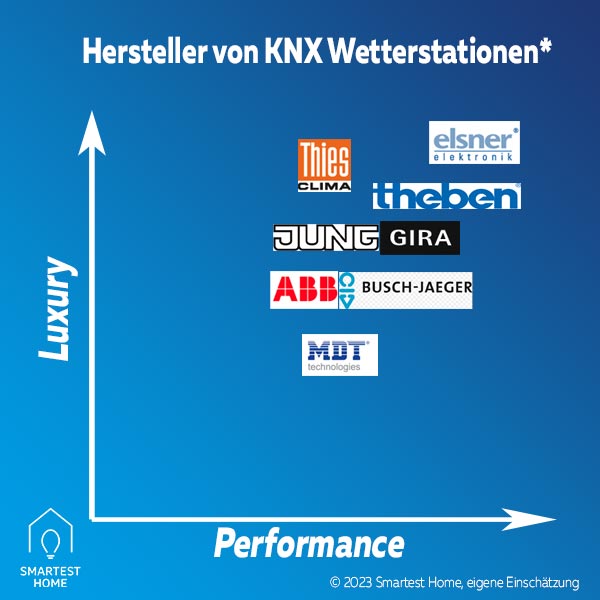
The benchmark for all KNX weather stations is, on the one hand, the technical equipment, which is reflected in the range of functions offered and the increasingly integrated sensors (GPS for date, time and geodata, outside temperature, wind speed, light and brightness, and rain gauge). On the other hand, high material quality is at least as important for many builders. After all, the weather station should do its job on the roof for many years and blend in with the building environment (facades, roofs) in terms of color and appearance.
While Elsner Elektronik (with the Suntracer KNX per weather station) and Theben (with the Meteodata 140 S GPS KNX) in particular are positioned in the upper segment, MDT and Busch-Jaeger, for example, address the broader market for new build KNX smart homes. Note: The graphic above shows a section of the market for KNX weather stations in German-speaking countries.
MDT Wetterstation Home
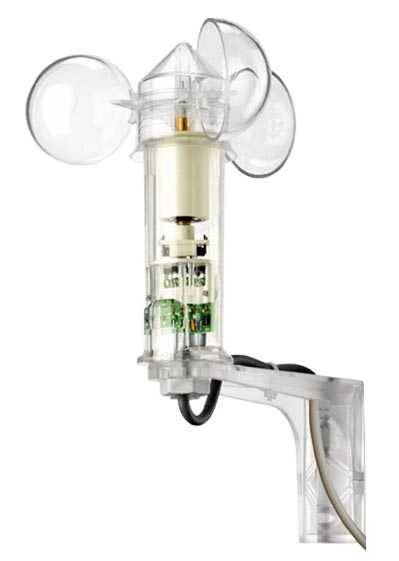
The MDT Wetterstation Home is a bit smaller and significantly lighter than most of the other candidates. It comes in a transparent plastic housing and can thus be integrated into any (roof and facade) background in a similarly inconspicuous manner as the Theben. To accurately measure wind speed, it has a mechanical wind wheel placed on top.
MDT does without a temperature sensor and a rain sensor including heating. The mechanical design is perhaps not quite as stable as it is compared to the other weather stations. The target group of this KNX weather station is thus clearly defined: Private and smaller single-family homes where the control/automation of a maximum of 3 facades (blinds or roller shutters) is important. The MDT weather station Home is calculated tightly and is available at the lowest price within the 300 euro mark in this comparison.
MDT benefits from its reputation in the KNX market – to be one of the most affordable providers ever – and is currently selling the small weather station to single-family house builders who already rely on the manufacturer for KNX push buttons and KNX actuators.
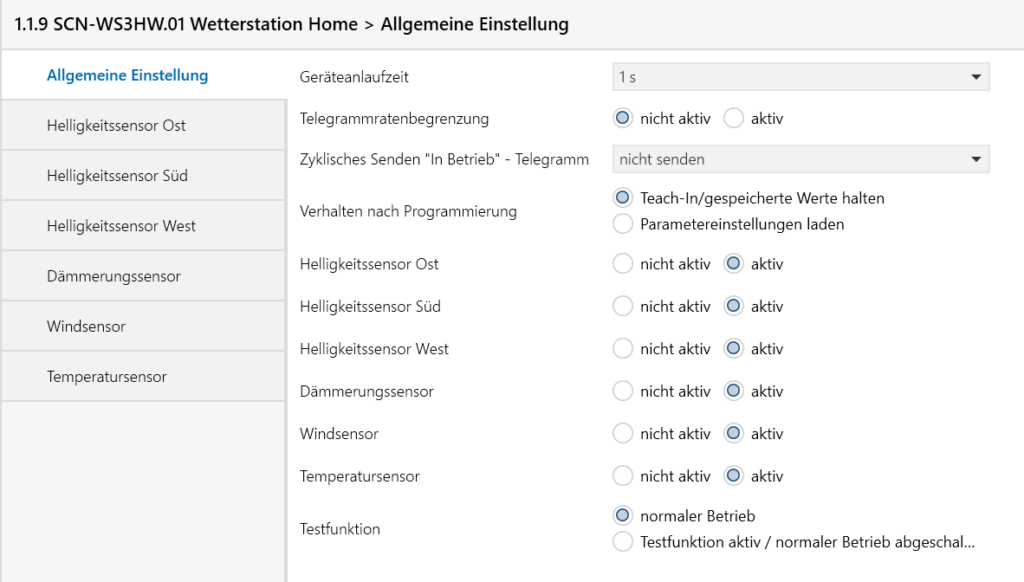
Elsner Suntracer KNX Pro Wetterstation
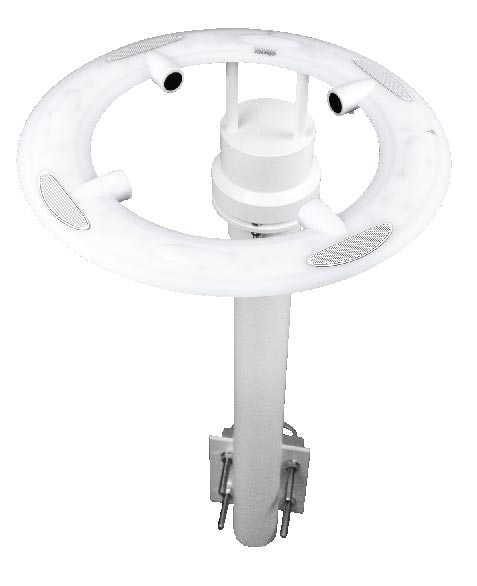
With the Suntracer KNX Pro weather station, Elsner is positioning itself very specifically in the market for KNX weather stations – at the very top in terms of functionality and price segment. For example: Compared to the other candidates, the Suntracer Pro can control and automate 12 different facades of a building as far as shading is concerned.
The Suntracer KNX Pro determines the wind speed using ultrasonic sensors, which can also measure the wind direction. The plastic housing, the workmanship and the material quality appear to be of very high quality, but we lack many years of practical experience with the Elsner Suntracer KNX Pro. Since the wind speed is measured “acoustically”, there are no moving parts like most other KNX weather stations in the form of a wind wheel.
And where is the Suntracer KNX Pro used? They are the larger buildings with many facades. With the latter, there are 12 facades that the Elsner Suntracer KNX Pro can control simultaneously and independently of one another. No other weather station in this comparison can do that. This high-end weather station currently costs up to 2200 euros.
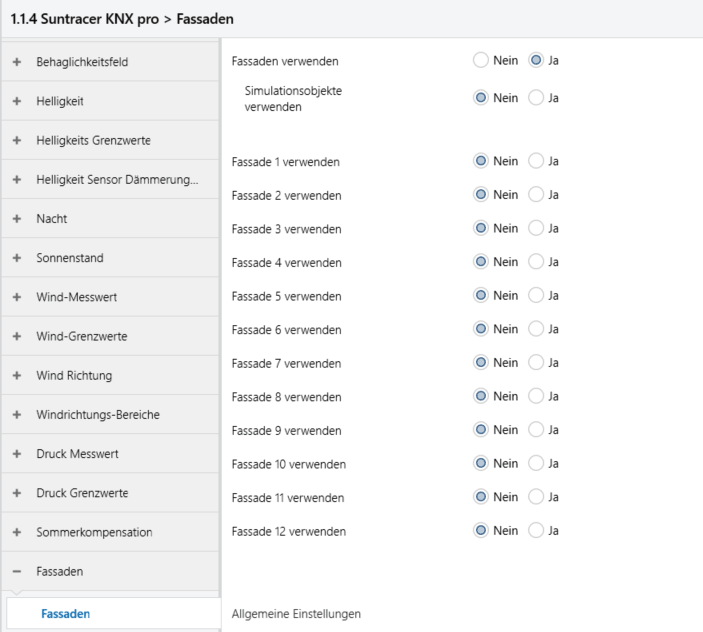
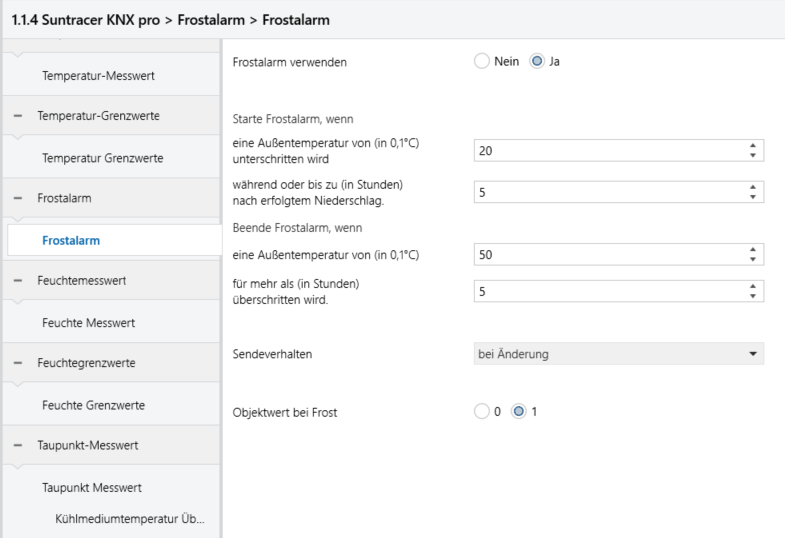
Gira Wetterstation Plus
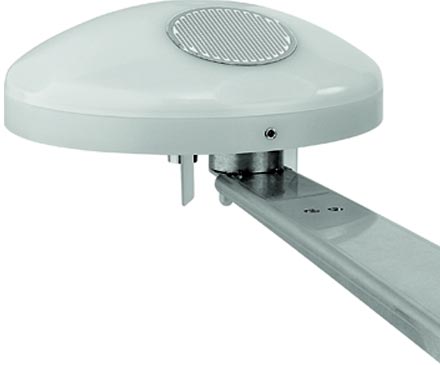
In addition to the Gira Wetterstation Standard, which is from our , there is also the Gira Wetterstation Plus (both KNX weather stations), which has a significantly expanded range of functions. Like the Elsner Suntracer KNX Pro, the Gira Wetterstation Plus can determine the wind direction. It provides further measured values in the form of humidity, global radiation (watts per square meter, which can be interesting in connection with Photovoltaic systems) and wind speed. The latter is determined electronically, since the KNX weather station does not have a mechanical anemometer/wind wheel. In conjunction with the determined air humidity, the Gira Wetterstation Plus can also output the “perceived temperature” on the KNX bus.
In general, the Gira Wetterstation Plus comes from the development of Thies Clima, a specialist for climatological measurement tasks and sensors. In terms of price, the KNX weather station is positioned in the upper segment, which is not surprising in view of the equipment and the functions offered.
From our experience, the Gira Wetterstation KNX Standard is no longer recommended. The reason: it often breaks after just 3 years and must therefore be replaced. And what often breaks? The integrated temperature sensor for measuring the outside temperature is no longer used in many house construction projects. The experience from our community shows a similar tendency. So it’s better to use the larger Gira version or another weather station!
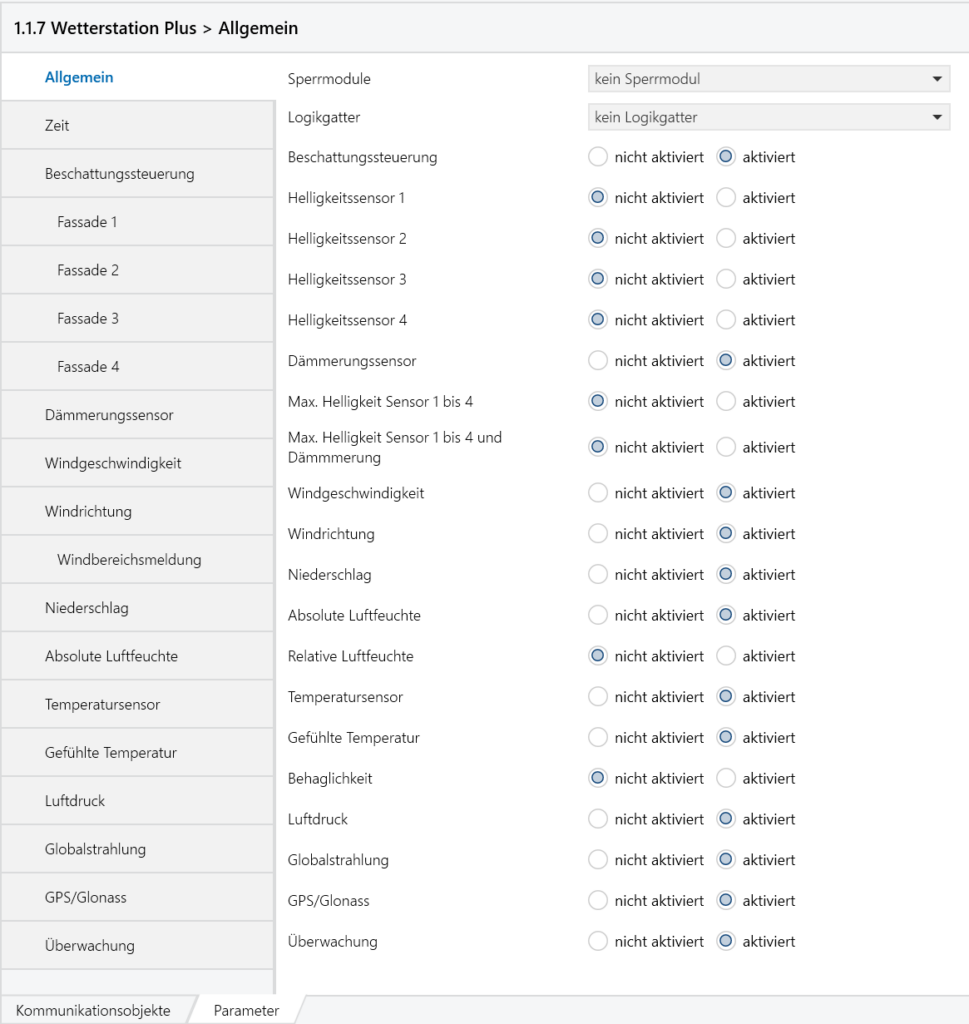
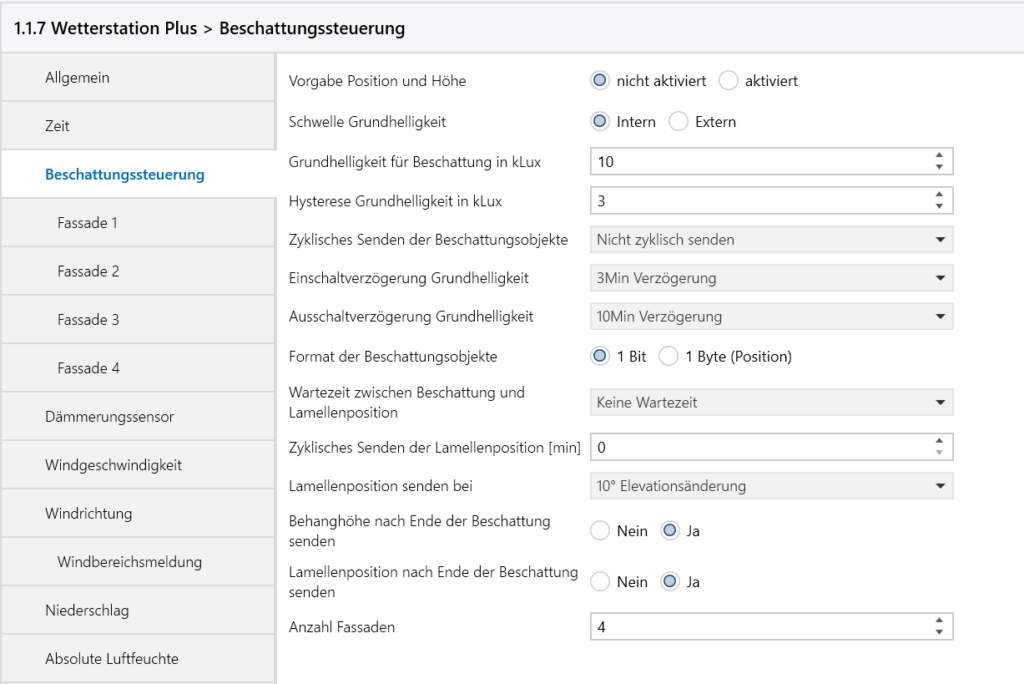
Theben Meteodata 140 S GPS KNX
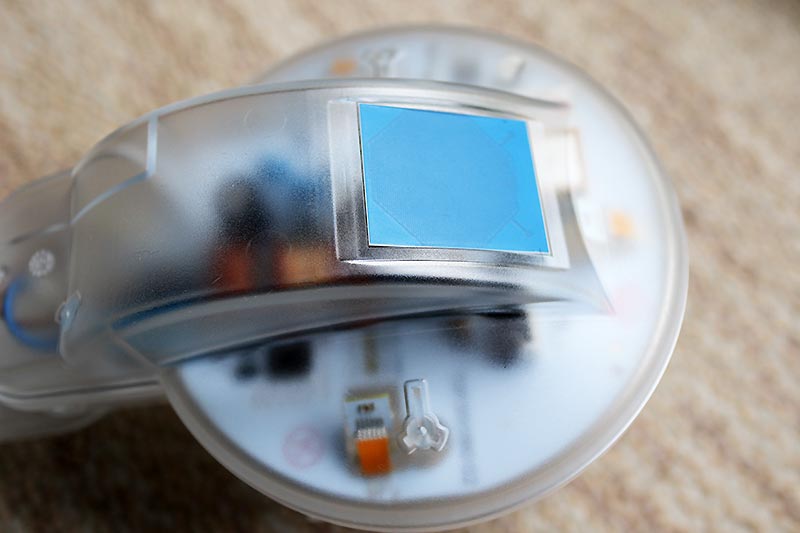
The Theben Meteodata 140 S GPS KNX weather station is the starting point for a whole range of manufacturers who do without an expensive in-house development and thus trust in the expertise of the traditional Swabian manufacturer Theben.
Theben also uses the Meteodata 140 S KNX in its own “Luxor Living” system, which can be seen as a kind of “KNX Lite” and can also be upgraded to native KNX. There is then the appropriate product database for insertion into the ETS5/6 software.
The top model is the Theben Meteodata 140 S GPS KNX, a KNX weather station that takes over the automatic shading of 8 different facades. It is clearly designed for larger and public buildings and villas (smart home villas) in the upper segment.
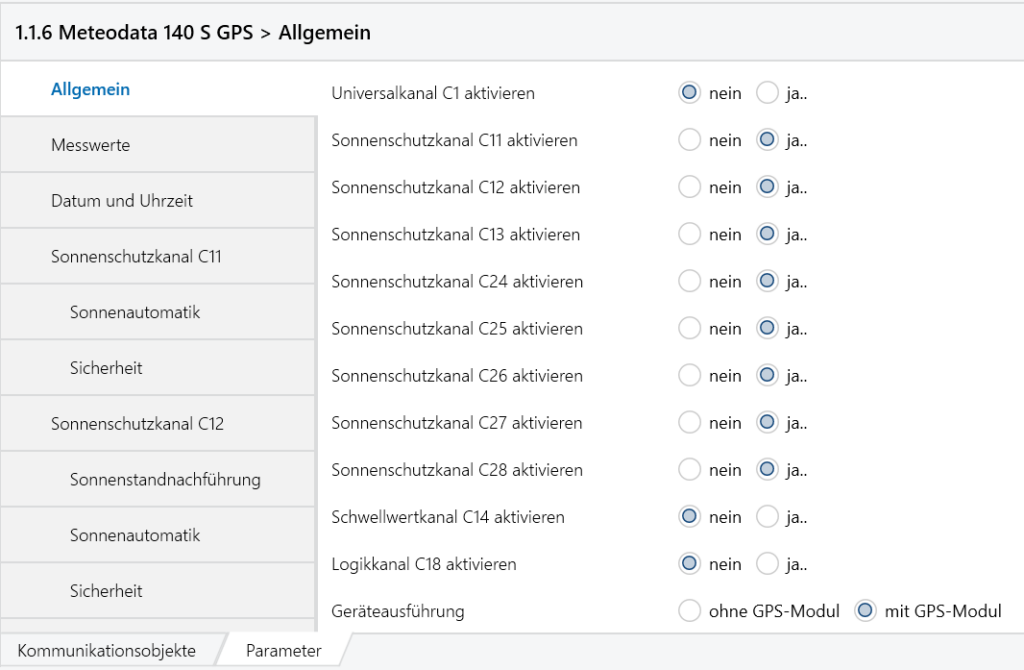
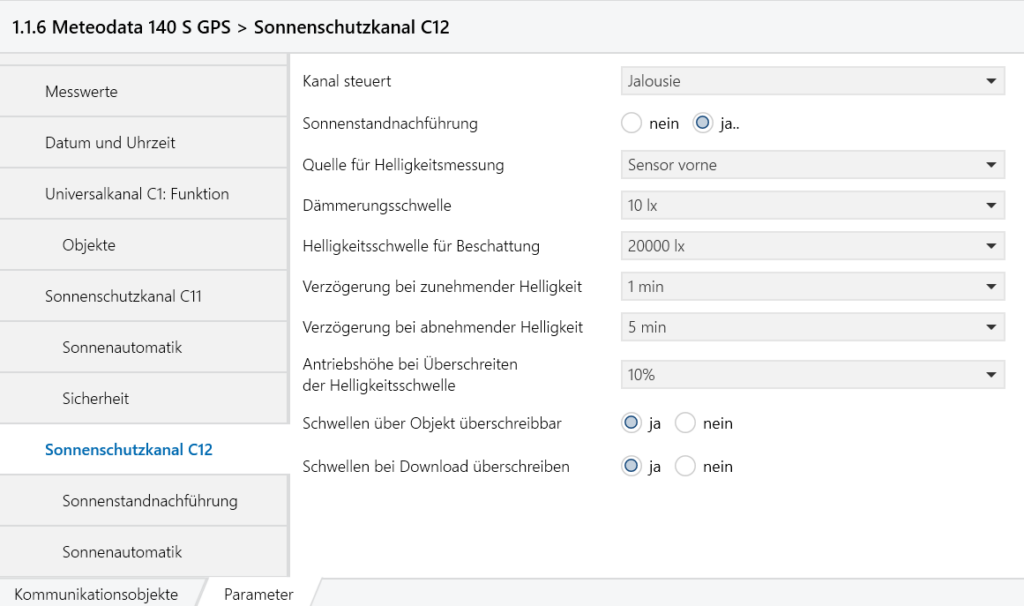

Where to install the KNX weather station?
A KNX weather station should be installed in a location where it allows accurate sensing of the current weather conditions to ensure effective control of the home or villa. However, the ideal position for mounting depends on various factors such as the type of building, the environment and the specific requirements of the system.
In general, the weather station should be installed in an open space on the roof of the house to enable accurate recording of the ambient temperature, humidity, air pressure and wind speed.
Additionally, the weather station should be installed in an area of the roof that is easily accessible and serviceable to allow for easy maintenance and monitoring.
